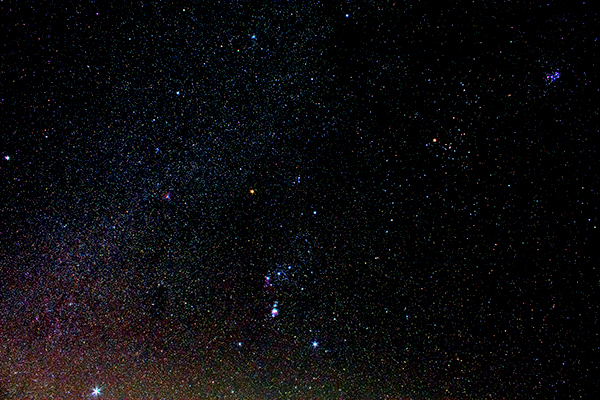Canadian winters can be quite harsh at times. Between the bone-chilling cold and piles of snow, this time of year plays host to the bright winter constellations. Orion – the Hunter is the most recognized pattern in the entire sky. The three stars appearing in a row signifying his belt, lie on the celestial equator meaning both the northern and southern hemispheres can see this group of seven stars portraying the Hunter battling Taurus the Bull.
Early sunsets allow one to begin star gazing and photographing the sky after dinner compared to around 10 pm in summer. Along with these seven bright suns, other constellations around Orion also display brilliant stars. In all, a dozen bright points of light reign the sky. Hanging down from the belt stars namely Alnitak, Alnilam and Mintaka is the imaginary sword. That misty patch of light is the Orion Nebula, a region of gas and dust located about 1,500 light-years (ly) away and measures an estimated 24 ly wide. Keep in mind one light-year measures close to 10 trillion kilometres. Within this region, new stars are being created as pockets of gas and dust slowly condense and collapse onto themselves. As the star grows, so does its internal pressure and temperature until the star lights up in a thermo-nuclear reaction.
Amongst the brighter constellations of Auriga, Gemini, Canis Minor and Major as well as Taurus are two brilliant planets. First is Jupiter located high in the night sky in the constellation Taurus. Jupiter is presently around 632 million kilometres or 35 light-minutes away whereas the orange-coloured star named Aldebaran to the lower right is 66 light-years from us. This star is referred to as the “angry eye of the bull” and is a foreground star of the much farther star cluster called the Hyades situated 154 light-years away. The Pleiades of “Seven Sisters” is a fantastic sight in low power binoculars and in mythology is the “heart” of the Bull.
Moving east we come to the constellation Gemini consisting of the bright stars Castor (51 ly) and Pollux (33 ly). Below and lining up with these two suns is Mars. Referred to as the red planet, it appears bright orange and will be close to Earth on January 16. This close approach occurs every 26 months thus allowing a good opportunity to see Martian surface features with a telescope. On the night of January 13, Mars will either be occulted and hidden by the moon for up to an hour or have a very near miss, depending on where you live in North America.
And let us not forget the planet Venus now in the lower western sky. It sets around 8:30 p.m. local time. To the upper left is the planetary jewel of the sky, Saturn. Taking on a yellowish hue, Saturn is now 83 light-minutes away. Venus and Saturn will be in conjunction (appearing closest in the sky) on the night of January 18. Today’s astronomy apps will help you identify the planets and learn the constellations. The night sky is a place of wonder that can be enjoyed all year round.
- The annual Geminid Meteor shower - December 12, 2025
- Full Moon Names - June 10, 2025
- March Lunar and Solar Eclipses - March 4, 2025
 Wawa-news.com You can't hear the 'big picture'!
Wawa-news.com You can't hear the 'big picture'!


